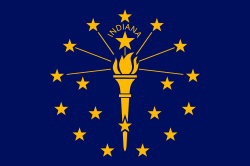
The following outline is provided as an overview of and topical guide to the U.S. state of Indiana:
Contents
- General reference
- Geography of Indiana
- Places in Indiana
- Environment of Indiana
- Regions of Indiana
- Demography of Indiana
- Government and politics of Indiana
- Federal government in Indiana
- Elections and political parties in Indiana
- Branches of the government of Indiana
- Law and order in Indiana
- Military in Indiana
- Local government in Indiana
- History of Indiana
- By period
- By region
- By subject
- More
- Culture of Indiana
- The arts in Indiana
- Sports in Indiana
- Economy and infrastructure of Indiana
- Education in Indiana
- See also
- References
- External links
Indiana – a U.S. state, was admitted to the United States as the 19th state on December 11, 1816. It is located in the midwestern United States and Great Lakes Region of North America. With 6,483,802 residents, as of the 2010 U.S. Census, the state is ranked 15th in population and 16th in population density. [1] [2] [3] Indiana is ranked 38th in land area [1] and is the smallest state in the contiguous U.S. west of the Appalachian Mountains. [4] Indiana's capital and largest city is Indianapolis, [5] the second largest of any state capital and largest state capital east of the Mississippi River.[ citation needed ]



